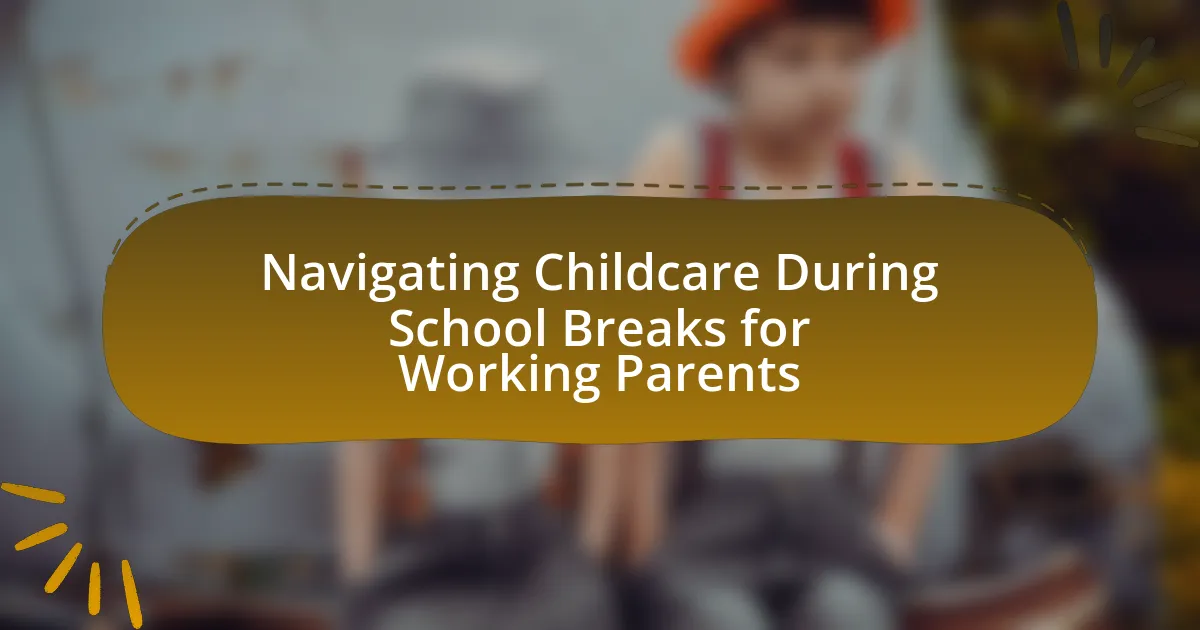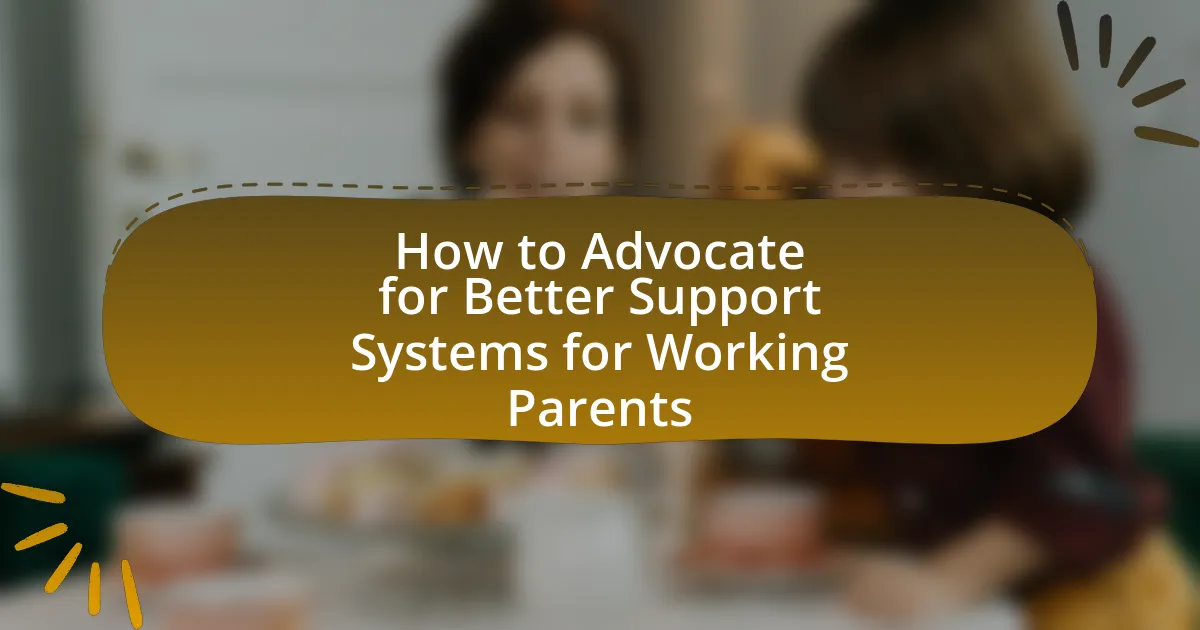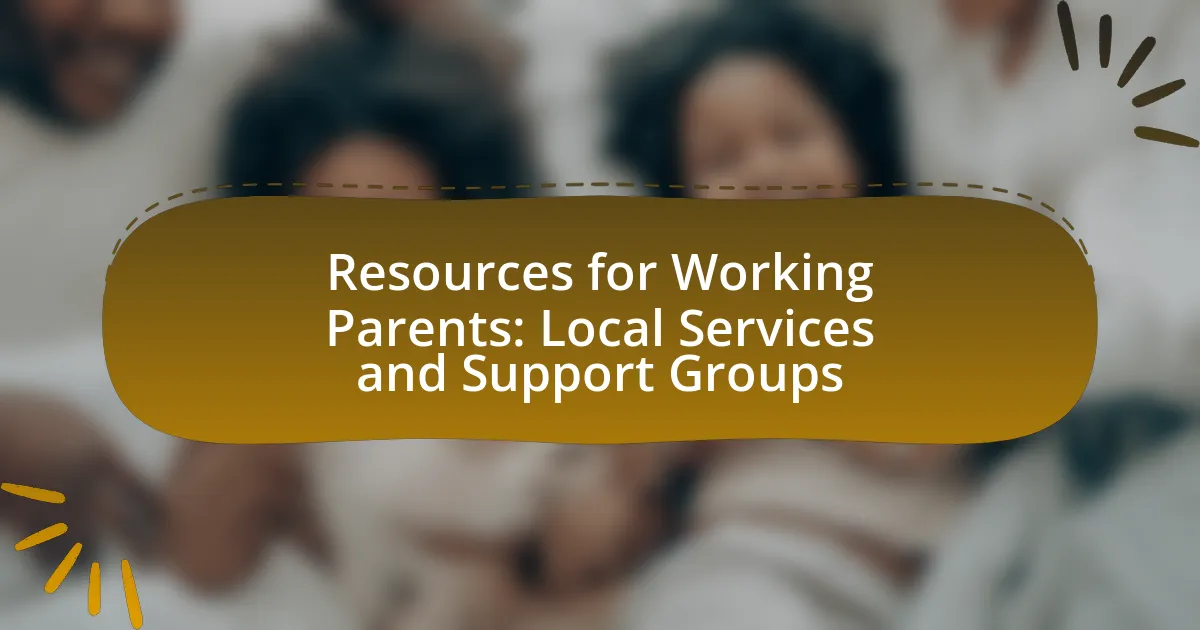The article focuses on the challenges faced by working parents during school breaks, particularly regarding childcare arrangements. It highlights the difficulties in securing affordable childcare, the impact on work schedules, and the emotional strain experienced by parents. Key topics include common scheduling conflicts, the effects on family dynamics, available childcare options, and strategies for effectively managing childcare needs. The article also emphasizes the importance of planning, utilizing community resources, and maintaining open communication to navigate these challenges successfully.

What challenges do working parents face during school breaks?
Working parents face significant challenges during school breaks, primarily related to childcare arrangements. The lack of structured school activities necessitates finding alternative care solutions, which can be both costly and difficult to secure. According to a survey by Care.com, 60% of parents reported difficulty in finding affordable childcare during school breaks, highlighting the financial strain this places on families. Additionally, many working parents experience scheduling conflicts, as their work commitments may not align with the availability of childcare services. This situation often leads to increased stress and anxiety, as parents must balance their professional responsibilities with the need to ensure their children are cared for during these periods.
How do school breaks impact working parents’ schedules?
School breaks significantly disrupt working parents’ schedules by requiring them to arrange alternative childcare solutions. During these breaks, parents often face challenges such as increased absenteeism from work, the need for flexible work hours, or the financial burden of hiring childcare services. According to a survey by the National Association of Child Care Resource & Referral Agencies, 70% of working parents report that school breaks create difficulties in managing their work commitments, leading to stress and decreased productivity.
What are the common scheduling conflicts during school breaks?
Common scheduling conflicts during school breaks include overlapping work commitments, lack of available childcare, and family obligations. Working parents often face difficulties aligning their work schedules with school break dates, which can lead to conflicts in finding suitable care for their children. According to a survey by the National Association of Child Care Resource & Referral Agencies, 60% of parents reported challenges in securing childcare during school breaks, highlighting the prevalence of this issue. Additionally, family events or travel plans can further complicate scheduling, as parents must balance personal commitments with professional responsibilities.
How do these conflicts affect family dynamics?
Conflicts arising from navigating childcare during school breaks significantly disrupt family dynamics. These conflicts can lead to increased stress among parents, resulting in strained relationships and communication breakdowns within the family unit. Research indicates that when parents face challenges in coordinating childcare, it can create feelings of frustration and resentment, which may negatively impact their interactions with each other and their children. For instance, a study published in the Journal of Family Psychology found that parental stress related to childcare responsibilities is linked to lower family cohesion and higher levels of conflict. This suggests that unresolved childcare issues can create a cycle of tension that affects overall family well-being.
What are the emotional impacts of school breaks on working parents?
School breaks significantly impact the emotional well-being of working parents, often leading to increased stress and anxiety. During these periods, parents face challenges in balancing work responsibilities with childcare needs, which can create feelings of guilt for not being present with their children. Research indicates that 60% of working parents report heightened stress levels during school breaks due to the lack of structured childcare options (Pew Research Center, 2020). Additionally, the disruption of routine can lead to feelings of overwhelm, as parents must navigate changes in their daily schedules and find alternative care solutions. This emotional strain can affect overall job performance and family dynamics, highlighting the need for supportive resources during school breaks.
How do parents feel about leaving their children during breaks?
Parents often feel anxious and guilty about leaving their children during breaks. This emotional response stems from concerns about their children’s safety, well-being, and social interactions while they are away. Research indicates that 60% of working parents express worry about finding reliable childcare options during school breaks, highlighting the stress associated with balancing work responsibilities and family needs. Additionally, parents frequently report feeling torn between their professional obligations and the desire to spend quality time with their children, further complicating their feelings about leaving them during these periods.
What stressors do parents experience during this time?
Parents experience significant stressors during school breaks, primarily due to the challenge of balancing work responsibilities with childcare needs. The lack of structured activities for children can lead to increased anxiety about finding adequate supervision and engagement for their kids. Additionally, financial strain often arises from the need to pay for childcare services or activities, which can be particularly burdensome during extended breaks. Research indicates that 60% of working parents report feeling overwhelmed by the demands of managing work and childcare simultaneously during these periods, highlighting the pervasive nature of this stress.

What childcare options are available for working parents during school breaks?
Working parents have several childcare options available during school breaks, including day camps, after-school programs, babysitters, and family care. Day camps often provide structured activities and supervision, catering to various interests such as sports, arts, or science, and typically run for a week or more. After-school programs may extend their hours during breaks, offering a familiar environment for children. Hiring a babysitter allows for personalized care in the home, while family members can also step in to provide support. According to the American Camp Association, over 14 million children attend day camps each summer, highlighting the popularity and availability of this option for working parents.
What types of childcare services can parents consider?
Parents can consider several types of childcare services, including daycare centers, family daycare, nanny services, babysitting, and after-school programs. Daycare centers provide structured environments for children, often catering to various age groups and offering educational activities. Family daycare involves care provided in a caregiver’s home, allowing for a more intimate setting. Nanny services offer personalized care in the family’s home, which can be tailored to the child’s specific needs. Babysitting typically involves short-term care, often arranged on an as-needed basis. After-school programs provide supervision and activities for school-aged children during the hours after school, often focusing on enrichment and socialization. These options cater to different needs and preferences, ensuring that parents can find suitable childcare during school breaks.
What are the differences between daycare, camps, and babysitters?
Daycare, camps, and babysitters serve different childcare needs. Daycare provides structured care for children, typically during working hours, and often includes educational activities and socialization with peers. Camps, on the other hand, are usually seasonal programs that focus on recreational activities, skill development, and social interaction, often during school breaks. Babysitters offer flexible, on-demand care, usually in the child’s home, and can cater to specific needs or schedules without the structured environment of daycare or camps. Each option varies in terms of structure, duration, and focus, making them suitable for different situations and parental needs.
How do parents choose the right type of childcare for their needs?
Parents choose the right type of childcare by assessing their specific needs, including work schedules, budget, and the developmental requirements of their children. They often evaluate options such as daycare centers, family care, or in-home childcare based on factors like convenience, cost, and the quality of care provided. Research indicates that 60% of parents prioritize safety and staff qualifications when selecting childcare, while 45% consider the proximity to their home or workplace as a critical factor. Additionally, parents may seek recommendations from other parents or consult online reviews to ensure they select a reliable and suitable childcare option.
How can parents find reliable childcare providers?
Parents can find reliable childcare providers by utilizing local resources, conducting thorough background checks, and seeking recommendations from trusted sources. Local resources include community centers, schools, and online platforms that specialize in childcare listings, which often provide reviews and ratings. Conducting background checks ensures that the provider has no history of misconduct, which is crucial for safety. Additionally, recommendations from friends, family, or parenting groups can lead to trustworthy options, as personal experiences often highlight the reliability and quality of care provided.
What resources are available for researching childcare options?
To research childcare options, parents can utilize several key resources. Government websites, such as Child Care Aware of America, provide comprehensive databases of licensed childcare providers, along with information on financial assistance and local regulations. Additionally, community organizations often offer directories and reviews of childcare services, helping parents assess quality and suitability. Online platforms like Care.com and Sittercity allow parents to search for caregivers based on specific needs and preferences, including background checks and ratings. Furthermore, local parenting groups on social media can serve as valuable forums for recommendations and experiences shared by other parents. These resources collectively support informed decision-making regarding childcare during school breaks.
How can parents assess the quality of childcare services?
Parents can assess the quality of childcare services by evaluating key factors such as staff qualifications, child-to-staff ratios, safety measures, and curriculum. Research indicates that higher staff qualifications and lower child-to-staff ratios correlate with better developmental outcomes for children. For instance, the National Association for the Education of Young Children (NAEYC) recommends a maximum ratio of 3:1 for infants and 10:1 for preschoolers to ensure adequate attention and care. Additionally, parents should observe the environment for safety hazards and assess the curriculum for age-appropriate activities that promote learning and social skills. Regular communication with staff and feedback from other parents can also provide insights into the service’s quality.

What strategies can working parents use to navigate childcare during school breaks?
Working parents can navigate childcare during school breaks by utilizing a combination of flexible work arrangements, community resources, and structured activities. Flexible work arrangements, such as remote work or adjusted hours, allow parents to be more available for their children. Community resources, including local childcare programs, summer camps, and after-school activities, provide structured care options. Additionally, parents can collaborate with other families to create shared childcare arrangements, which can reduce costs and ensure children have social interactions. Research indicates that 60% of working parents rely on community programs during school breaks, highlighting the effectiveness of these strategies.
How can parents effectively plan for school breaks?
Parents can effectively plan for school breaks by creating a structured schedule that includes activities, childcare arrangements, and family time. Establishing a calendar with designated days for outings, educational activities, and relaxation helps ensure that children remain engaged and parents can manage their work commitments. Research indicates that structured schedules during school breaks can enhance children’s emotional well-being and academic performance, as they provide a sense of stability and predictability. Additionally, utilizing local resources such as community programs, camps, or playdates can alleviate childcare challenges while fostering social interactions for children.
What tools can help parents organize their childcare needs?
Parents can utilize various tools to effectively organize their childcare needs, including mobile applications, scheduling software, and online platforms. Mobile applications like Care.com and Sittercity allow parents to find and connect with local childcare providers, while scheduling software such as Google Calendar helps parents manage their time and coordinate care arrangements. Additionally, online platforms like Facebook groups or local community forums provide resources and support from other parents, facilitating the sharing of recommendations and experiences. These tools enhance organization and communication, making it easier for parents to navigate childcare during school breaks.
How can parents communicate their needs to childcare providers?
Parents can communicate their needs to childcare providers by clearly articulating their expectations and requirements during initial meetings and ongoing discussions. Effective communication involves being specific about schedules, dietary restrictions, behavioral expectations, and any special needs the child may have. Research indicates that open dialogue fosters a collaborative relationship, which is essential for ensuring that the childcare provider can meet the family’s needs effectively. For instance, a study published in the Journal of Child Care in Practice highlights that regular check-ins and feedback sessions between parents and providers significantly enhance the quality of care and satisfaction for both parties.
What are some tips for balancing work and childcare during breaks?
To balance work and childcare during breaks, parents should establish a structured schedule that allocates specific times for work and childcare activities. This approach allows parents to focus on work tasks while ensuring that children have designated play or learning time. Research indicates that structured routines can enhance productivity and reduce stress for working parents, as they provide clarity and predictability (American Psychological Association, 2020). Additionally, utilizing resources such as childcare programs or playdates can help alleviate the burden of supervision, allowing parents to concentrate on their work responsibilities.
How can parents set boundaries between work and family time?
Parents can set boundaries between work and family time by establishing a clear schedule that designates specific hours for work and family activities. This structured approach helps parents communicate their availability to both their employers and family members, ensuring that work responsibilities do not encroach on family time. Research indicates that maintaining a consistent routine can enhance work-life balance, as it allows parents to allocate dedicated time for family interactions, which is crucial for children’s emotional well-being. Additionally, using tools like calendars or apps to block off family time can reinforce these boundaries, making it easier for parents to adhere to their commitments.
What practices can help reduce stress during school breaks?
Practices that can help reduce stress during school breaks include establishing a structured routine, engaging in physical activities, and incorporating mindfulness techniques. A structured routine provides predictability, which can alleviate anxiety for both parents and children. Engaging in physical activities, such as sports or outdoor play, has been shown to release endorphins, improving mood and reducing stress levels. Mindfulness techniques, such as meditation or deep-breathing exercises, can enhance emotional regulation and promote relaxation, contributing to a calmer environment during breaks. These practices are supported by research indicating that routine and physical activity positively impact mental health and stress management.
What are the best practices for ensuring a smooth transition during school breaks?
To ensure a smooth transition during school breaks, parents should establish a structured schedule that includes consistent routines for activities, meals, and rest. This approach helps children feel secure and reduces anxiety associated with changes in their daily environment. Research indicates that children thrive on predictability; for instance, a study published in the Journal of Child Psychology and Psychiatry found that structured routines can significantly enhance children’s emotional well-being and adaptability. Additionally, parents should communicate openly with their children about the upcoming break, discussing plans and expectations to foster a sense of involvement and control. Engaging children in planning activities can also promote excitement and reduce resistance to change.
How can parents prepare their children for changes in routine?
Parents can prepare their children for changes in routine by establishing clear communication about the upcoming changes and involving them in the transition process. This approach helps children understand what to expect and reduces anxiety associated with uncertainty. Research indicates that children who are informed about changes and allowed to express their feelings about them adapt more easily, as they feel a sense of control and involvement in their own lives. For instance, discussing the new schedule, practicing the new routine together, and providing reassurance can significantly ease the adjustment period.
What role does communication play in managing expectations?
Communication is essential in managing expectations, particularly for working parents navigating childcare during school breaks. Effective communication ensures that all parties involved—parents, caregivers, and children—have a clear understanding of schedules, responsibilities, and limitations. For instance, when parents communicate their work commitments and availability, caregivers can better plan activities and care routines, reducing the likelihood of misunderstandings. Research indicates that clear communication can lead to improved satisfaction and reduced stress among parents, as it aligns everyone’s expectations and fosters a collaborative environment.
What resources can assist working parents during school breaks?
Working parents can utilize various resources during school breaks, including local community centers, summer camps, and online childcare platforms. Community centers often offer structured programs that provide supervision and activities for children, ensuring a safe environment while parents work. Summer camps, both day and overnight, provide engaging experiences that can enhance children’s social skills and learning. Online childcare platforms, such as Care.com or Sittercity, connect parents with qualified caregivers who can provide flexible childcare options tailored to their schedules. These resources collectively support working parents by offering reliable childcare solutions during school breaks.
What community programs are available for children during breaks?
Community programs available for children during breaks include summer camps, after-school programs, and recreational activities organized by local community centers. These programs often provide structured environments where children can engage in educational and recreational activities, ensuring their safety and development while parents are at work. For instance, the American Camp Association reports that over 14 million children attend summer camps each year, highlighting the popularity and availability of such programs. Additionally, many community centers offer specific programs during school breaks that focus on arts, sports, and STEM education, catering to diverse interests and age groups.
How can online platforms support parents in finding childcare solutions?
Online platforms can support parents in finding childcare solutions by providing searchable databases of local childcare providers, user reviews, and comparison tools. These platforms often aggregate information about availability, pricing, and services offered, enabling parents to make informed decisions quickly. For instance, a study by the Urban Institute found that 70% of parents reported using online resources to find childcare, highlighting the effectiveness of these platforms in streamlining the search process. Additionally, many platforms offer features such as direct messaging with providers and booking capabilities, further simplifying the process for working parents during school breaks.
What are the key takeaways for working parents navigating childcare during school breaks?
Key takeaways for working parents navigating childcare during school breaks include planning ahead, utilizing community resources, and maintaining open communication with employers. Planning ahead allows parents to secure childcare options early, reducing last-minute stress. Community resources, such as local camps or programs, often provide structured activities that keep children engaged while parents work. Open communication with employers can lead to flexible work arrangements, such as remote work or adjusted hours, which can ease the childcare burden. These strategies help ensure that both work responsibilities and children’s needs are effectively managed during school breaks.





























